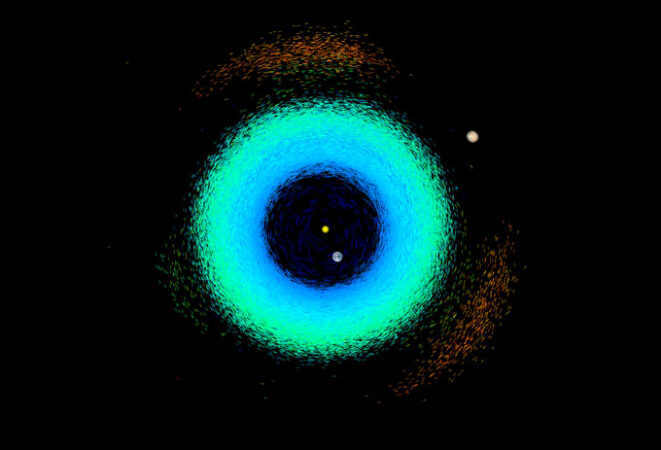1.6 billion stars. 11.4 million galaxies. 158,000 asteroids.
One spacecraft.
The European Space Agency’s Gaia space observatory, which launched in 2013, has long surpassed its goal of charting more than a billion stars in the Milky Way (SN: 10/15/16). On June 13, the mission extended that map into new dimensions, releasing more detailed measurements of hundreds of millions of stars, plus — for the first time — asteroids, galaxies and the dusty medium between stars.
“Suddenly you have a flood of data,” says Laurent Eyer, an astrophysicist at the University of Geneva who has worked on Gaia for years. For some topics in astronomy, the new results effectively replace all the observations that were taken before, Eyer says. “The data is better. It’s amazing.”
Data in the new survey, which were collected from 2014 to 2017, are already leading to some discoveries — including the presence of surprisingly massive “starquakes” on the surfaces of thousands of stars (SN: 8/2/19). But more than anything, the release is a new tool for astronomers, one that will aid their efforts to understand how stars, planets and entire galaxies form and evolve.
Here are a few of the long-standing puzzles the data could help solve.
Asteroid mishmash
The asteroid belt between Mars and Jupiter is a mess of history. After the Earth and other planets formed, the rocky building blocks that were left over smashed into each other, leaving behind jumbled fragments. But if scientists know enough about individual asteroids, they can reconstruct when and where they came from (SN: 4/13/19). And that can provide a peek into the solar system’s earliest days.

Gaia’s massive new dataset may help solve this puzzle, says Federica Spoto, an astrophysicist at the Harvard-Smithsonian Center for Astrophysics in Cambridge, Mass. It includes data on the chemical makeup of over 60,000 asteroids — six times more than researchers had such details on before using other tools. That information can be essential for tracing asteroids back to their shattering origins.
“You can go back in time and try to understand all the formation and evolution of the solar system,” says Spoto, a Gaia collaborator. “That’s something huge that before Gaia we couldn’t even think about.”
Asteroids aren’t just pieces of the past, though; they’re also dangerous. The new data could reveal asteroids that are next to impossible to spot from Earth because they orbit too close to the sun, says Thomas Burbine, a planetary scientist at Mount Holyoke College in South Hadley, Mass., who is not involved with the mission (SN: 2/15/20). Since these asteroids would have originally come from farther out (say, the asteroid belt), they can tell us about the rocks going past Earth that can potentially hit us. “We’ll know our neighborhood better,” Burbine says.
Dating a star
It is notoriously difficult to measure the age of stars (SN: 7/23/21). “It’s not uncommon to have uncertainty of more than a billion years,” says Alessandro Savino, an astrophysicist at the University of California, Berkeley who is not involved with Gaia. Unlike brightness or location, age is not directly visible. Astronomers have to rely on theories of how stars evolve to predict ages from what they can measure.
If past versions of the Gaia survey were like a photograph of stars, the new release is like shifting the photograph from black and white to color. It provides a deeper look at hundreds of millions of stars by measuring their temperature, gravity and chemistry. “You imagine the star as this point in space, but then they have so many properties,” Spoto says. “That’s what Gaia is giving you.”
Although these kinds of measurements are far from new, they have never been collected in the Milky Way on such a scale before. Those data could provide more insight into how stars evolve. “We can improve the resolution of our clocks,” Savino says.
Milky Way snacks
Though it may seem unchanging, the Milky Way is actually gorging on a steady diet of smaller galaxies —it’s even in the process of eating one right now. But for decades, predictions of when and how these cosmic mergers happen have been at odds with evidence from our galaxy, says Bertrand Goldman, an astrophysicist at the International Space University in Strasbourg, France, who is not involved in the Gaia data release. “That has been controversial for a long time,” Goldman says, “but I think that Gaia will certainly shed light.”
The key is to be able to pick apart different structures in the Milky Way and see how old they are (SN: 1/10/20). Gaia’s latest release helps in two ways: By mapping the chemistry of stars and by measuring their motion. Previous versions of the survey described how millions of stars were moving, but mostly in two dimensions. The new catalog quadruples the number of stars with full 3-D trajectories from 7 million to 33 million.
This has implications beyond our neighborhood. Most of the mass in the universe is contained in galaxies like the Milky Way, so knowing how our own galaxy works goes a long way to understanding space on the largest scales. And the more scientists understand the parts of galaxies they can see, the more they can learn about dark matter, the mysterious substance that exerts gravity but doesn’t interact with light (SN: 6/25/21).
Even as astronomers mine this latest dataset, they are already looking ahead to future treasure hunts. The next round is years off, but it is expected to enable the discovery of thousands of exoplanets, produce rare measurements of black holes and help astronomers clock how fast the universe is expanding. In part, this is because Gaia is designed to track the motion of objects in space, and that gets easier as more time passes. So Gaia’s observations can only get more powerful. “Like good wine, they age very, very well,” Savino says.

